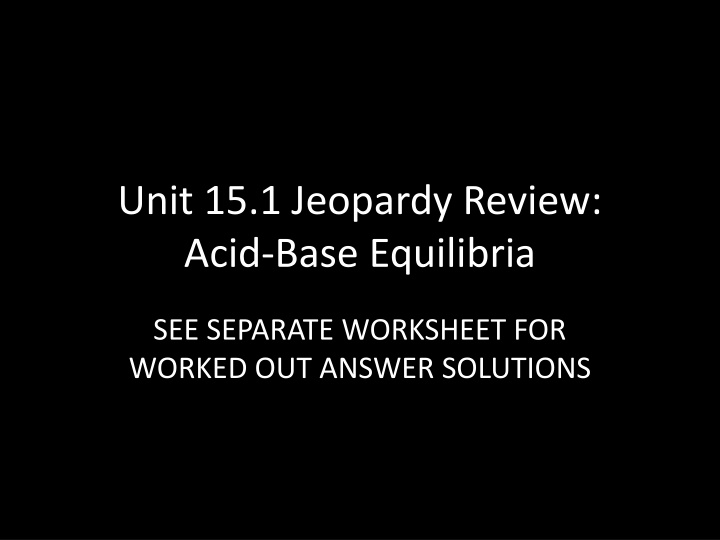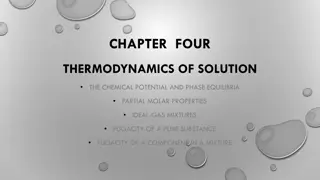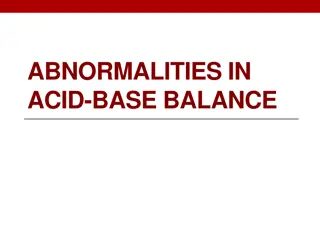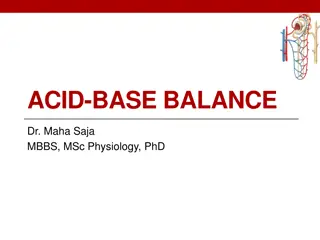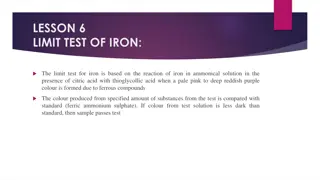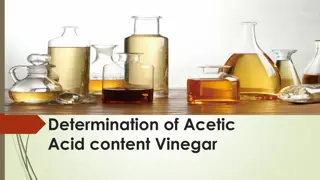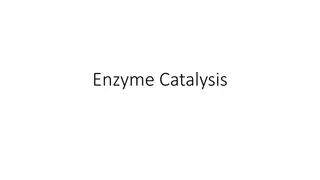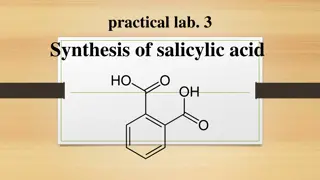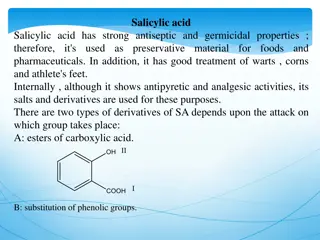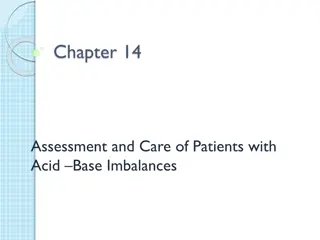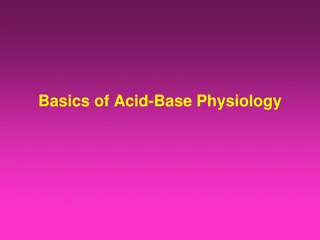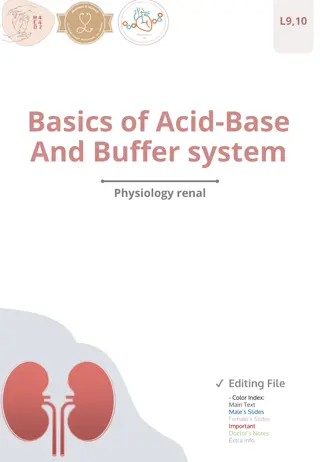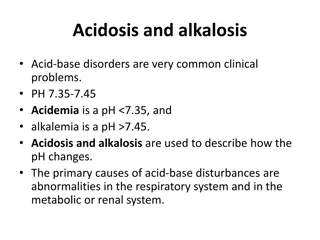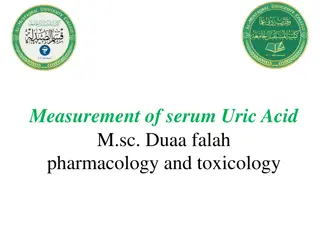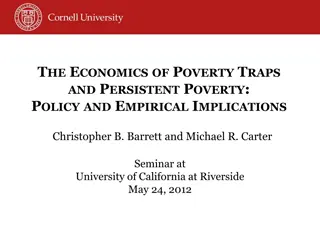Acid-Base Equilibria Jeopardy Review
Test your knowledge on acid-base equilibria with this interactive Jeopardy review worksheet. Explore properties of acids, neutralization reactions, definitions of acids and bases, and more. See if you can answer the questions correctly and check your solutions for each question.
Uploaded on Feb 24, 2025 | 1 Views
Download Presentation

Please find below an Image/Link to download the presentation.
The content on the website is provided AS IS for your information and personal use only. It may not be sold, licensed, or shared on other websites without obtaining consent from the author.If you encounter any issues during the download, it is possible that the publisher has removed the file from their server.
You are allowed to download the files provided on this website for personal or commercial use, subject to the condition that they are used lawfully. All files are the property of their respective owners.
The content on the website is provided AS IS for your information and personal use only. It may not be sold, licensed, or shared on other websites without obtaining consent from the author.
E N D
Presentation Transcript
Unit 15.1 Jeopardy Review: Acid-Base Equilibria SEE SEPARATE WORKSHEET FOR WORKED OUT ANSWER SOLUTIONS
Question #1 Which of the following is a property of an acid? a) Feel like water b) Turn litmus paper blue c) React vigorously with metals higher on the activity series d) Taste bitter e) Conduct electric current *You may choose more than one option
Answer #1: a) Feel like water c) React vigorously with metals higher on the activity series e) Conduct electric current
Question #2 In a neutralization reaction, strong acids combine with strong bases so that the properties of both are lost. What are the 2 general products of a neutralization reaction?
Answer #2: water + salt
Question #3 Which statement below is true? a) An Arrhenius acid accepts hydrogen ions when dissolved in water. b) A Bronsted-Lowry base generates hydroxide ions when dissolved in water. c) A Lewis acid can accept a pair of electrons.
Answer #3: c) A Lewis acid can accept a pair of electrons.
Question #4 Name two problems with the Arrhenius definition of acids and bases.
Answer #4: It is restricted to aqueous solutions. It does not explain why some bases do not contain OH-ions (ex: NH3)
Question #5 Give the name AND formula for the seven strong acids we discussed in class.
Answer #5: Hydrochloric Acid, HCl Hydrobromic Acid, HBr Hydroiodic Acid, HI Chloric Acid, HClO3 Perchloric Acid, HClO4 Sulfuric Acid, H2SO4 Nitric Acid, HNO3
Question #6 All of the alkali metals, when combined with hydroxide, are considered to be strong bases. Which three alkaline earth metals are also classified as strong bases when combined with hydroxide? *Give chemical formula of these bases
Answer #6: Calcium Hydroxide - Ca(OH)2 Strontium Hydroxide - Sr(OH)2 Barium Hydroxide - Ba(OH)2
Question #7 Name the following acids: HCN H2SO3 H2CO3
Answer #7: HCN hydrocyanic acid H2SO3 sulfurous acid H2CO3 carbonic acid
Question #8 Give the formulas for the following acids: Acetic acid Hydrobromic Acid Phosphorous Acid
Answer #8: Acetic acid HC2H3O2 Hydrobromic Acid HBr Phosphorous Acid H3PO3
Question #9 Name this ion: H3O+
Answer #9 H3O+ - hydronium ion
Question #10 What word do we use to describe a substance that is capable of acting as either an acid or a base?
Answer #10: Amphiprotic or amphoteric
Question #11 The stronger an acid or a base, the ____ its conjugate pair. Therefore, an acid and its conjugate base (or a base and its conjugate acid) have a(n) ____ relationship.
Answer #11: The stronger an acid or a base, the weaker its conjugate acid or conjugate base. Therefore, an acid and its conjugate base or a base and its conjugate acid have a(n) inverse relationship.
Question #12 Give the conjugate base for the following Bronsted-Lowry acids: PH4+ H2O CH3COO-
Answer #12: PH3 OH- CH2COO2-
Question #13 Give the conjugate acid for the following Bronsted-Lowry bases: HSO4- H2O CO32-
Answer #13: H2SO4 H3O+ HCO3-
Question #14 In the reaction below, which substance is acting as the conjugate base? H2SO4+ NH3 HSO4-+ NH4+
Answer #14: Conjugate base = HSO4-
Question #15 Write two chemical equations for the reaction of HSO3-with water: one in which HSO3-acts as an acid, and one in which it acts as a base. Be sure to include states of matter.
Answer #15: HSO3-(aq) + H2O (l) SO32-(aq) + H3O+(aq) HSO3-(aq) + H2O (l) H2SO3(aq) + OH-(aq)
Question #16 What word do we use to describe an acid that has more than one ionizable H atom?
Answer #16: Polyprotic
Question #17 H2SO4is a polyprotic acid. Show how this acid can go through consecutive removals of a hydrogen ion when added to water. Be sure to include states of matter.
Answer #17: H2SO4(aq) + H2O (l) HSO4-(aq) + H3O+(aq) HSO4-(aq) + H2O (l) SO42-(aq) + H3O+(aq)
Question #18 Calculate the [OH-] concentration when the [H+] = 5.35 x 10-11M, and determine if the solution is acidic, basic or neutral.
Answer #18: [OH-] = 1.87 x 10-4M; basic
Question #19 A solution has the exact same [H+] and [OH-]. What is the only possible [H+] concentration (molarity) for this solution? Would you classify this solution as acidic, basic or neutral?
Answer #19: [H+] = [OH-] = 1.0 x 10-7M; neutral
Question #20 A solution has a pOH of 8.87. What is its [H+]? Would you classify this solution as acidic, basic or neutral?
Answer #20: [H+] = 7.49 x 10-6M; acidic
Question #21 Find the pH of a 0.00476 M hydrochloric acid solution.
Answer #21: pH = 2.32
Question #22 Find the pOH of a solution that contains 3.25 g of H2SO4dissolved in 2.75 L of solution.
Answer #22: pOH = 12.38
Question #23 If the pH = 9.85, what is the concentration of a solution of Sr(OH)2?
Answer #23: [Sr(OH)2] = 3.54 x 10-5M
Question #24 Calculate the pOH when 12.5 mL of a 0.015 M Ca(OH)2is diluted to 0.5 L.
Answer #24: pOH = 3.12
Question #25 An acid has a Kavalue that is equal to 2.5 x 10-11. Is this acid most likely a strong acid or a weak acid? Why?
